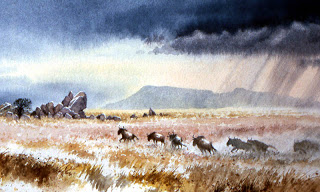One of the after-dinner features of many of my painting courses has been Bellamy’s Bedtime Stories which developed after requests from students, and I’ve been asked if I can include some of these into the blogs. Robert, one of my students who is sadly no longer with us, had a delightful mischievous streak and asked me to literally tear into his painting at the final critique. He’d painted it especially for the purpose and he was a good painter. With the group gathered I began with Robert’s work, explaining what a marvellous rendition of the subject he’d made, but I didn’t like the right-hand side, so to everyone’s horror I tore a 3-inch vertical strip off the paper and declared that that was much better. However, I then pointed out that it was slightly unbalanced and that we needed to remove the top part of the sky, and so tore another strip off. By now many in the group were eyeing their own paintings piled up on the table and wondering whether they should rescue them.
I continued with a denigration of the over-worked foreground (which was actually well done!), and with a severe frown announced that much of that would have to go as well. By now the painting was less than half its original size. I found a particularly “revolting” passage and tore that off, continuing in that way until the whole thing was reduced to the size of a large postage stamp, at which point I declared it was a truly outstanding work of art. Many of the students were in the know and the non-painting partners found it rather entertaining. I no longer do such severe appraisals, but while Robert was with us anything could happen. We do miss him greatly.
How did you get on with the scene of Carn Llidi? I promised in an earlier blog I would show you my version which you can see below. I decided to work mainly in greys with spots of colour here and there, darkening the sky to highlight the peak. The buildings were pushed nearer to the peak and stand out against the strong darks immediately behind. The telegraph pole was achieved with white gouache which I have also used to scrub in to add interest in places. The foreground is almost abstract with stony shapes and splashes of reds and ochres. The painting was done on Saunders Waterford rough paper which I find superb for creating textural effects. The original photograph shows how much I have altered the scene. Of course there are an infinite number of ways to respond to a subject – there is no one ‘right’ way, but my aim here was to stimulate a different way of looking at a scene and also to encourage you to look at your sketches and photographs with a view to trying all sorts of approaches, perhaps even trying five or six completely different ways to paint a scene.
Keep painting and stay safe…….



